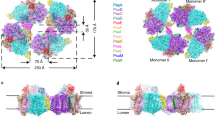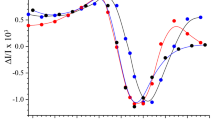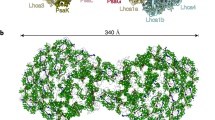Abstract
Oxygen-evolving photosystem II (PSII) complex is consisted of a number of intrinsic components including the chlorophyll-binding inner antenna CP47, CP43, the reaction center proteins D1 and D2, the α and β subunits of cytochrome b559, several low molecular weight subunits, and at least one extrinsic protein of 33 kDa, together with 40 chlorophylls. The total molecular weight of PSII is about 250 kDa, assuming there is one of each subunit in a monomeric PSII. The PSII complex can be isolated from cyanobacteria and higher plants in both dimeric and monomeric forms with essentially the same protein composition (see 1 for a review). Several possibilities may be considered as the causes for the presence of dimer and monomer of purified PSII. First, PSII may exist as a dimer in thylakoids in vivo, which was partially disintegrated into monomer upon detergent solubilization during the purification procedure. Second, PSII exists as a monomer in vivo; detergent solubilization may alter the surface structure in some part of the PSII complex, leading to a dimerization of PSII in vitro. Finally, PSII may exist in both dimeric and monomeric forms in vivo, which can be purified in parallel by the purification procedures so far used. Although freeze-fracture analyses of thylakoid membranes by electron microscopy from both cyanobacteria and higher plants suggested that PSII may exist predominantly in the dimeric form in vivo (1), these analyses had a low resolution and the results obtained have not been proved yet. Thus, whether PSII exists as a dimer or monomer in vivo is still a matter of debate.
Preview
Unable to display preview. Download preview PDF.
Similar content being viewed by others
References
Rögner, M., Boekema, E.J. and Barber, J. (1996) TIBS 21, 44–49.
Berthold, D.A., Babcock, G.T. and Yocum, C.F. (1981) FEB S Lett. 134, 231–234.
Enami, I., Kamino, K., Shen, J.-R., Satoh, K. and Katoh, S. (1989) Biochim. Biophys. Acta 977, 33–39.
Ikeuchi, M. and Inoue, Y. (1988) Plant Cell Physiol. 29, 1233–1239.
Hankamer, B., Nield, J., Zheleva, D., Boekema, E., Jansson, S. and Baber, J. (1997) Eur. J. Biochem. 243, 422–429.
Author information
Authors and Affiliations
Editor information
Editors and Affiliations
Rights and permissions
Copyright information
© 1998 Springer Science+Business Media Dordrecht
About this chapter
Cite this chapter
Shen, JR. (1998). Possible Functional Differences Between Dimer and Monomer of Photosystem II Complex. In: Garab, G. (eds) Photosynthesis: Mechanisms and Effects. Springer, Dordrecht. https://doi.org/10.1007/978-94-011-3953-3_222
Download citation
DOI: https://doi.org/10.1007/978-94-011-3953-3_222
Publisher Name: Springer, Dordrecht
Print ISBN: 978-0-7923-5547-2
Online ISBN: 978-94-011-3953-3
eBook Packages: Springer Book Archive




